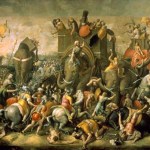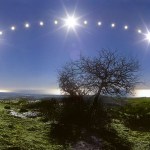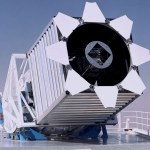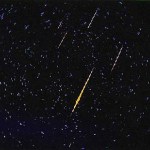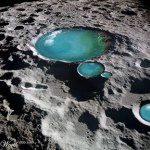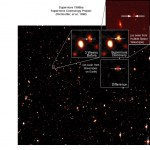Astronomy
One of things I like to think about in science is "how do we know that?" It is interesting how one thing builds on another. This is a story of how the Greeks estimated the distance from the Earth to the Sun (an important idea in the development of the model of the solar system). I like this story because it is not too complicated. In fact, one could easily reproduce these measurements themselves. So, here is what I will talk about:
Measuring the size of the Earth.
Determining the distance from the Earth to the moon and the size of the moon.
Calculating the distance (and size) to the Sun…
I discerned huge Orion, driving wild beasts together over the field of asphodel, the very ones that he once had killed on lonely mountains, he grasped in his hands a mace of bronze, never to be broken.
-Odysseus, in the Underworld, The Odyssey
With a reputation as the greatest hunter ever and as one of the largest, tallest men ever, it's no wonder that Orion lives on in both song,
and in our imaginations in the sky as well.
Orion is one of the most easily identifiable constellations in the sky; it was the second one I ever learned how to find, right after the Big Dipper. The three stars on…
I have come not to make war on the Italians, but to aid the Italians against Rome.
-Hannibal of Carthage
Today is Christmas Day, but did you know that this holiday, in addition to being a solstice celebration, has its origins in the second Punic War? Beginning in 218 B.C., the Romans suffered a number of, well, fairly crushing defeats at the hands of Hannibal of Carthage. You've probably heard the story of Hannibal crossing the Alps with elephants (although, according to some sources, only one survived), and invading Italy, making it all the way to the city walls of Rome.
Roman morale was…
Yesterday was the winter solstice, meaning the sun concluded its six-month southward course and seemed to "stand still" before beginning its journey north. Of course, this being a heliocentric neighborhood, the tilt, orbit, and rotation of Earth are what really move the sun through the sky. But don't let that stop you from appreciating colorful crayon diagrams of the ancient "two-sphere" model of the heavens with Dr. Free-Ride on Adventure in Ethics and Science. If that's not a useful enough approximation, you can get a modern understanding of solstices and seasonal dynamics from Anne…
Thanks to NASA's Terra satellite for providing this image:
That tiny little white bar on the lower left, by the way? That's the scale of this image: 50 km (31 miles).
You know, as opposed to how it normally looks, when it isn't covered in snow:
Happy Holidays again! And a special thanks to Universe Today for showing this off, too!
Kenneth: These are my all inclusive holiday decorations. Here's a little Christmas tree.
Tracy: Ok.
Kenneth: A menorah.
Tracy: Dig.
Kenneth: A picture of President Obama for the Muslims.
Tracy: I'm gonna let that one slide.
Kenneth: And a bowl of meat cubes with a picture of Jimmy Connors sticking out in the tradition of Verdukianism. -30 Rock
It's the Winter Solstice today. This is one of my favorite holidays, and arguably, is the first holiday in all of human history. (Pardon the Northern-Hemisphere bias of this post.) How so, you ask?
Typically, the Sun rises in the East, travels higher…
Before you were conceived I wanted you
Before you were born I loved you
Before you were here an hour I would die for you
This is the miracle of love. -Maureen Hawkins
But I'm not talking about human children, I'm talking about the children of the stars. Stars burn their fuel until they no longer can, and then die in one of two impressive ways, depending on how massive they are. If a star is up to around four times as massive as our Sun, it dies by collapsing down to a white dwarf and blowing off its outer layers into a planetary nebula.
On the other hand, if your star is very massive -- like…
On Aardvarchaeology, Martin Rundkvist tells us that the Geminid meteor shower is peaking tonight, so if you've got any wishes on the back burner, now's your chance to make them. Of course these shooting "stars" are really bits of extinct comet 3200 Phaethon's "sandy exhaust trail" burning up in the atmosphere—if you prefer some main sequence hydrogen-fusing affairs, head over to Greg Laden's Blog to learn about Alcor and Mizar. This binary star system in the constellation Ursa Major has been known since antiquity, but—surprise!—Mizar is actually four stars, and Alcor is now known to be two…
The solar system is difficult to show correctly. Why? It is difficult because the size of things are vastly different. Let me use units common in solar-system astronomy, the Astronomical Unit (or AU). One AU is the distance from the Sun to the Earth. If I want to look at all the planets, I would need to go out to about 30 AU (to Neptune - remember that Pluto is not a planet). That is not a problem but then if I want to look at the size of even the Sun, it is just 0.001 AU across. And the Earth is even smaller, at 0.0001 AU. So that is the problem. The distance from the Sun to Neptune…
Earlier this week, I showcased the newly-released Hubble Ultra Deep Field in the infrared, and compared it with the older image of the same region taken in visible light.
As many astute readers noticed, the newer image looks blurrier than the old one! This is true, and there's a good reason for this. Here's one of the old images from the Ultra Deep Field (in visible light):
and here's that same region in infrared light.
Yes, the latter image is blurrier. Why is it blurrier? One of the biggest differences between infrared light and visible light is their wavelengths; visible light goes from…
They will see us waving from such great heights
"Come down now," they'll say.
But everything looks perfect from far away
"Come down now," but we'll stay. -Postal Service
We've been over this twice before, but here's a refresher on how you image the farthest galaxies in the Universe. Pick a spot in the sky that's empty. What does empty mean? When you look with your eyes, with binoculars, and even with a reasonable telescope, you find no bright stars, no bright galaxies, no nebulae, no clusters -- in short nothing -- except for the absolute faintest of objects.
You know, something like this…
Have you been keeping up with The Boston Globe's Hubble Advent Calendar? Today's picture is totally worth talking about, and gives me a chance to tell you about these little guys that just hang-on to our galaxy: globular clusters. When you look out at a galaxy -- pretty much any galaxy -- you'll find these tiny clumps of light surrounding it.
These clumps are actually amazing, dense collections of stars! If you look out at the nearest star to us, it's Proxima Centauri, located just over four light years away. That means if you drew a sphere centered on the Earth four light years in radius,…
So, it snowed here (in Louisiana). Sure, it wasn't a lot, but it was still a big deal. The following day, there was still some snow on the house roofs. I took some pictures. Here is a shot looking at the North side of a house.
And here is a view of the South side of the same roof.
What is so cool about that? All the houses were the same way. North side of roof = snow. South side = no snow. At first, I was going to use these pictures to talk about flux. Basically, since the Sun is lower in the South sky the southern side of the roof gets more solar energy flux. Then I realized my…
Follow humbly wherever and to whatever abyss Nature leads, or you shall learn nothing. -T.H. Huxley
We've spent a little bit of time talking about dark energy, including what we think of it, how we first discovered it, and how we knew that there wasn't just something out there blocking the light. It seems to be the latest abyss that Nature is leading us, so we needed to look beyond the type Ia supernova data and see what else the Universe was telling us.
Image credit: Don Dixon.
So what do we do? First off, we can try to measure how much matter is in the Universe independent of anything…
If you've never been to the Galaxy Zoo website, you have been missing out. The Sloan Digital Sky Survey is a pretty impressive telescope, but the wide-field camera system on it is what's truly amazing. Have you ever seen a telescope that looks like this before?
This telescope surveys a huge area of the sky, taking the highest resolution pictures of tremendous regions of space. We not only get to take a census of a very large region of space, we also get unique views on -- literally -- hundreds of thousands of galaxies. This gives us both the forest and the trees. Sure, I may write more about…
Some meteor showers are spectacular, while most are mundane. If you sit around during a typical shower, you might see anywhere from 50 to 100 meteors an hour, if the Moon isn't out.
If you take a time-lapse photograph and look for meteors, you will, sometimes, get a great view of what's going on. Although it isn't immediately clear what's a meteor and what's a passing satellite or airplane, you can tell them apart in this video by looking for the "instant" streaks, which are meteors, versus the ones that streak for many frames, which are satellites or aircrafts.
Well, the Leonids peak…
On Friday, NASA scientists confirmed the discovery of water on the moon. Using spectral analysis to determine the composition of the plume resulting from last month's LCROSS rocket collision, they found more than 100 liters of water. Steinn Sigurðsson on Dynamics of Cats calls the presence of water on the moon "amazing," but cautions that at these concentrations, it's "dry by Earth standards." Razib Khan on Gene Expression considers the implications of water on the moon: "Since humans are mostly water by weight, this is very important when assessing the practical difficulties of…
I thought I should consult you first before I went ahead with my plan to destroy the Moon. -Greg Angelone, via The Straight Dope
Last week, scientists from LCROSS announced that they had detected "a buttload" of water on the Moon. Let's go over what happened and what it means.
The Moon is very different from Earth. It has no atmosphere (literally, less than one atom thick), day-and-night lasts for two weeks apiece, and the temperature extremes are horrifically severe. But one of the biggest differences? Whereas the Earth is tilted at 23.5 degrees as it goes around the Sun, the Moon is tilted…
In Ethan Siegel's ongoing treatment of dark energy on Starts With A Bang!, he considers a number of alternative explanations for the dimming of redshifted supernovae. Could photon-axion oscillations be to blame, or does a "grey dust" pervade our universe? In another post, Siegel appreciates that our galaxy smells like raspberries and rum, and not, for example, Uranus. His diss to Andromedans: "I bet you stink compared to us!" For more things unseen, Greg Laden on Collective Imagination points us to Kameraflage, a technology that writes secret messages and draw pictures only visible to a…
Though the Sun is gone, I have a light. -Kurt Cobain
Last time we visited dark energy, we discussed its initial discovery. This came about from the fact that supernovae observed with a certain redshift (i.e., moving away from us) appear to be systematically fainter than we were able to explain.
But we weren't satisfied with simply saying that there must be dark energy. We asked a lot of critical questions about why these supernovae might appear so faint.
First off, we asked the question, "Could these supernovae from far away be different than the type Ia supernovae we have today?"…

